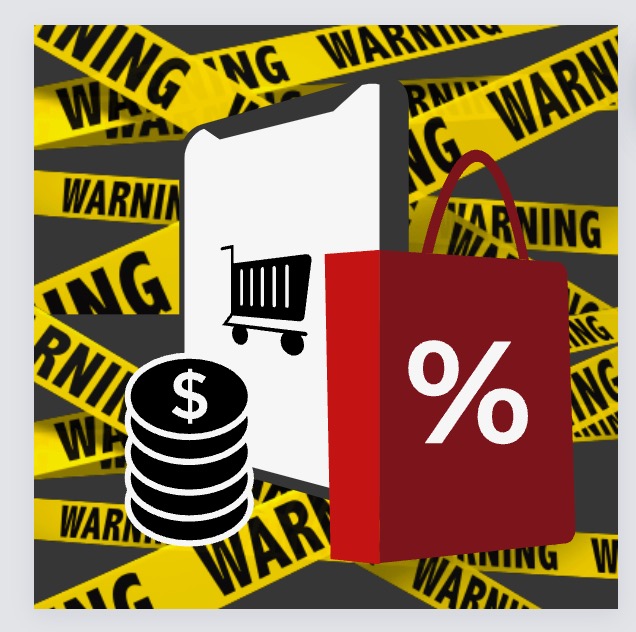Add to cart, click some buttons, wait a couple of business days and voilà — this month’s “must-have closet staple” arrives on your doorstep. The convenience of online shopping for clothes is undeniable, regardless of whether you live in the heart of a bustling city or among the cow-dotted pastures of Upstate New York, access to any and every garment imaginable lies at your fingertips. Online shopping can be stimulating, easy and gratifying, but the cycle of dissatisfaction it promotes is detrimental not only to your bank account, but to the environment, to the appreciation of enduring fashion and to yourself. It consigns you to an endless search for the next new product rather than yielding contentment with what you already have.
The problem with online shopping lies in its overwhelming convenience. When you don’t need to drive to the nearest stores – or even lift your head from the pillow, buying anything that’s even the slightest bit appealing becomes thoughtless. Nowadays, because of online shops and the mass production of relatively inexpensive “fast fashion” items, the act of buying clothes has lost significant value. New features on social media platforms like Instagram and TikTok allow users to click on a post to access direct links to buy the clothes worn in that video or picture, permitting one to shop online without even interrupting their mindless scrolling. Technology like this removes yet another inconvenience — the arduous endeavor of switching apps to manually search up a website — and further simplifies an already effortless process. With fewer and fewer steps that complicate the purchasing of new clothes, there is an increasing tendency to disregard whether a purchase is really necessary and motivated by genuine desire or whether the enticement of its accessibility is just irresistible.
The phrase “all good things require effort” rings true when it comes to online shopping, and I don’t mean the effort put into gaining the 50 dollars that you drain from your checking account after pressing “pay now.” Rather, I think of the effort it takes to travel to a store, try on clothes and weigh whether the piece you’re about to buy is something you really want — something you would be willing to take time out of your day to obtain.
Knowing that the internet grants you the ability to buy anything at any given moment contributes to a cycle of discontentment, and, if anything, it takes effort to resist buying something even when you have the option. While online shopping might produce a sense of instant gratification, the meager consideration and effort it takes to press “buy now” too often results in a lack of satisfaction with the product itself, thus incentivizing people to buy something new again, once the excitement of a package “arriving soon” subsides. This action pattern fosters a constant dependence on the external gratification of making online purchases and an incessant fixation on what piece you will buy next that looms regardless of how many pieces you purchase.
Because online shopping requires little effort, it is far too easy to purchase items without considering if it will really contribute to your closet or if it will be worn once then sit, crumpled up and ignored in the depths of a neglected drawer. Online shops capitalize off of the allure of online shopping’s convenience, pumping out what seems like hundreds of new products a week, constantly trying to conform to current trends and target those who fail to resist their urges to constantly revamp their closet. However, with the accessibility of online stores comes the unfortunate reality that everyone has access to all the same websites and products. Thus, when trends emerge, multitudes of people can fall victim to the temptation of buying the same products, resulting in an utter lack of stylistic individualism. Once the realization that seemingly everyone clicked the same link and is now wearing the same exact sweater as you becomes apparent, said sweater loses appeal — after wearing it once or twice, it joins the drawer of other regretted online purchases. This tendency to wear pieces of clothing only a few times is not only frustrating from an individual financial standpoint — it is also incredibly harmful for the environment. The environmental cost of packaging shipped products is but another consequence of online shopping. According to Earth.org, packages from online shopping in 2020 alone accounted for 1.8 million tons of plastic waste and nearly 10 million tons of paper waste.
Obviously, exceptions to the wholly harmful nature of online shopping exist: you spend months saving up for a special piece that you can imagine wearing and cherishing for years, and online shopping provides access to said piece if there are no stores nearby. However, more often than not, the allure of making online purchases is more appealing than the product itself. Resisting the temptation to buy a piece you find desirable in the moment requires self-restraint. You must ask yourself if you would be willing to take real time and effort to obtain a product and consider if you can envision yourself still wearing it in a year, five or ten. Not only will this help you create a more timeless closet, but it will also eliminate the dissatisfaction that arises when you dissipate your savings on valueless stuff.













